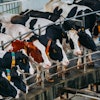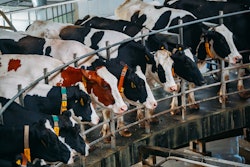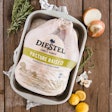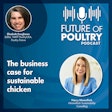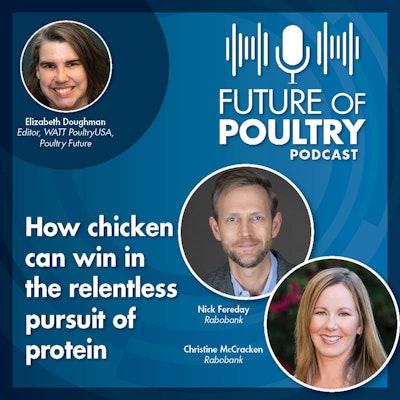
Elizabeth Doughman, editor, WATT PoultryUSA and Poultry Future: Hello, I’m Elizabeth Doughman, the editor of WATT PoultryUSA and Poultry Future. In today’s episode, my guest is Nick Fereday, executive director, Rabobank and Christine McCracken, protein analyst, also at Rabobank.
Nick is one of our featured speakers at the 2025 Chicken Marketing Summit, scheduled for July 28-30 at the DeSoto Savannah in Savannah, Georgia. This one-of-a-kind event explores issues and trends in food marketing and consumer chicken consumption patterns and purchasing behavior.
Registration is now open at ChickenMarketingSummit.com, with an early bird discount expiring on May 31, and I’d like to encourage everyone to attend.
Thanks for joining us today, Nick and Christine.
How have consumer perceptions around healthy eating changed within the past five years?
Fereday: That's an incredible question in the sense that so much has happened over the last five years. You could have said the last five hours, given what's going on in Washington these days, or even five weeks.
I'm actually reminded of what happened four or five years ago when the plant-based movement really took off. We're now in a situation where only yesterday, some of the famous names are being valued at a fraction of the amount of money that they raised. There was a fungi mycelium company called Meati with a meat replacement that had raised over $450 million and, sadly, was sold for the princely sum of four or 5 million yesterday.
And that kind of shows you we can get very excited about a so-called healthy trend and see it disappear over the course of a few years, but a hell of a lot has happened since then. We've obviously had COVID and people eating more at home and cooking far more from home. We've had an inflationary period, and now we still seem to be in the midst of a protein mania, where anything to do with protein seems to go down well with consumers, and, more recently, it's all about MAHA (Make America Healthy Again).
McCracken: I think a big part of Make America Healthy Again is about protein. I think that trend specifically has been a really big piece of the consumer focus over the last 12 to 18 months. I think you probably agree we've seen a real shift.
But the question is, is, how are they able to hit those protein goals? There's a lot of solutions being offered, and I think, Elizabeth, you might agree that the chicken is a big part of that story, specifically when we're talking about not only the focus on health, but really in meeting the protein goals that are that are quickly becoming a part of the narrative.
Doughman: What health trend is currently having the biggest impact on chicken consumption?
Fereday: I would say it is this protein story. We're used to consumers cycling through the three macronutrients, falling in and out of favor of carbohydrates and fat and we seem to be stuck on protein right now. It's almost like a perennial trend.
I've just come back from a trade show a couple of months ago, and every other booth was touting the protein content, saying that we're a peak protein. I think what's super interesting is how protein is kind of popping up in every aisle now. And that's an opportunity and also a risk for the chicken industry because it's way beyond the meat and freezer aisles where you would normally associate chicken products. It's turning up in pasta sauce. It's turning up in candy. It's kind of added protein whether that's a plant-based or a dairy based, like wave type protein powder.
The question really is, while it's an absolutely fantastically large market now, to what extent can chicken capture some of this in any particular shape or form?
McCracken: If you look think through the trend in the last few years, it's been all about clean label. How you get that protein will be an interesting trend to watch in that a lot of focus has been put on a lot of these highly processed foods. Adding protein to any specific product – candy included – might be a target, right?
If you think about where we're headed in terms of further processing, I do think there's a great story for chicken and other proteins to talk about what they bring to the table when you think about the single source protein.
Fereday: As we often see in consumer trends, there's a lot of contradictions. To what extent are people coming to terms with this concept of highly processed, ultra processed foods and trying to limit their consumption, but at the same time making exceptions for their protein powder or the other protein supplement?
I think it's important to know that a lot of people are saying that we've probably passed peak protein and it can't get any bigger. But I think there are a couple of drivers that will kind of continue the trend towards more protein.
The one that's front of mind for me is the new market for the anti-obesity medical medications such as GLP-1 drugs, Ozempic and Wegovy and the like. Because people on those drugs are trying to lose weight, but they're also, in addition to losing body weight, they're losing a proportion of lean muscle mass as well. They signed up to lose their body fat, but didn't sign up to lose their muscle. Users of these drugs, and it could be as high as 10% of U.S. adults now, are looking for more protein in their diet to kind of compensate or offset the negative impact on what's happening to their body weight.
Doughman: How can chicken brands position themselves as part of a healthy lifestyle without resorting to token health claims?
McCracken: I think that a lot of the effort in in the protein industry, and specifically in chicken, is to quantify all of the benefits that that consuming lean animal protein impart on the consumer. We've all always considered protein, and specifically chicken, to be a great source of protein,
I think that the real struggle is now, when consumers are demanding a little bit more visibility or transparency around what that means and how it might benefit them. The industry has to step up and really think about how they communicate those benefits, providing the scientific background or the data behind what we already know to be a really healthy protein alternative.
I think that's part of the story. Looking back at our conversation earlier, which is to say that that it's a single source protein, and it's not highly processed in most cases, and that consumers have already have really good options to supplement their diets with good proteins. All of that becomes part of this strategy, I think.
I do think there's going to have to be a clear message on how we communicate some of these benefits, whether it's directly unpack or if it's really some more support around the products to get consumers really aligned or understanding that the true health benefits of consuming those products, I think that's maybe where we could spend some time as an industry to help consumers.
Fereday: I agree. I said earlier that protein possibly hasn't peaked. I hope that dumb protein has peaked in the sense that a lot of companies just want to shout the protein content in their product, and I don't think that's very helpful.
I think the first thing for the industry to understand is why people are consuming protein, and what's driving that. Is it to fill them up? Is it the impact of health and wellness trends? Is it the weight loss drugs and so on? That will certainly help you target but certainly also add some kind of level of sophistication to the marketing. You're not just screaming out that chicken contains x many grams of protein, but maybe talk about the quality of protein and the source of that protein, because proteins are made up of different combinations of amino acids, and some are more incomplete and complete than others. Also, our protein requirement is really a moving target. It depends on your age and on your level of activity. You know whether you're male or female or whatever and your needs change as well.
So again, when you start to dig into the who is consuming chicken, and when are they consuming it, that may give you some ideas that you may want to pitch it differently as well. The MAHA movement under RFK Jr. is all about radical transparency. He's under the belief, which is certainly plausible, that if you provide consumers with the relevant information, they will make better choices in their food.
To Christine's point, the more you can tell your story and explain the quality of the chicken, the completeness of the protein, etc,, that will go down very well with consumers.
Doughman: What is your favorite chicken dish to eat?
Fereday: I'm a traditionalist in the sense that roast chicken for me, and that's part of the whole story you often see in food where nostalgia and memories play a role in one's choices. The things that you remember eating as a child, and those happy memories around Sunday meals and things are all tied into roast chicken for me.
McCracken: That's a great story. For me, it really depends on where I am that week.
I eat a lot of chicken. And what I love about chicken is that there's so many ways to prepare it, right? You're talking about a lot of variety, which I think is why chicken has done so well, and not just at home, but in retail. I always turn to chicken and dumplings during the winter and chicken piccata in the summer.
It's flexible that way, because it's hardy in the winter when I need it, especially in the north, but it can be light, right? You know, a little lemon and some capers, and you're good to go.
I love all things chicken, obviously, but those are a few of my favorites.
Doughman: Thanks again, Nick and Christine, and thanks to you for tuning in.
To hear more of Nick’s insights and learn more about the consumer behavior and trends impacting today’s chicken consumption, register to attend by visiting ChickenMarketingSummit.com.
For more episodes of the Future of Poultry podcasts, please like and subscribe on WATTPoultry.com or wherever you access podcasts.

